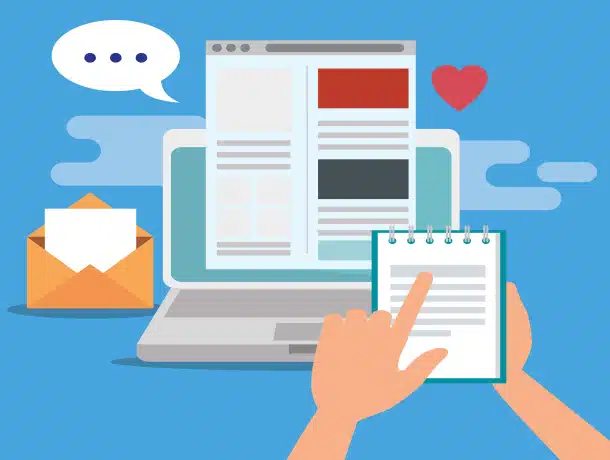
- July 12, 2023
- content marketing, content writing, email marketing
- Content Writing
What is newsletter content writing?
Writing newsletter content is the process of producing written content that is intended to be sent out on a regular basis via email or other channels to a particular audience. The content of newsletters often includes news, updates, advice, recommendations, and promotions connected to a particular subject or business that are relevant to and entertaining to the target audience.
Depending on the newsletter’s goal and target readership, its content can vary greatly. For instance, a business might utilize a newsletter to inform its clients of corporate news, market updates, and promotional offers. An organization may utilize a newsletter to inform its members of upcoming occasions and significant problems pertaining to its mission.
writing should be entertaining and educational, and it should be customised to the target audience’s particular interests and needs. Also, it should be well-written, aesthetically pleasing, and simple to read and navigate. In order to develop a devoted readership and keep readers interested over time, it’s critical to keep the newsletter release schedule regular.
Important factors for newsletter content writing

Businesses, organizations, and people can interact with their audience in a more engaging and personal way by using newsletters, a common kind of content marketing.
- Set your target market and objectives.
You must identify your newsletter’s target readership and objectives before you begin writing. Who do you hope your newsletter will reach? This will assist you in producing material that is valuable and pertinent to your viewers.
- Create a content strategy.
You may better organise your thoughts and make sure that your newsletter is consistent and pertinent by creating a content plan. The subjects you intend to cover, the structure of your newsletter, and the frequency of distribution should all be part of your plan.
- Put quality before quantity.
A few high-quality pieces in your newsletter are preferable to a large volume of poor content. Make sure your writing is clear, informative, and interesting.
- The use of images
Your newsletter can be made more interesting and memorable by using visuals like pictures, videos, and infographics. Also, they can aid in text breaks and improve the readability of your content.
- Make it brief and sweet.
Because people have limited attention spans, it’s critical that your newsletter be brief and direct. Have a concise and straightforward writing style, and only provide the most vital details.
- Make your newsletter unique.
Personalizing your newsletter can improve the connection you have with your subscribers. Provide content that is pertinent to their interests and needs and greet them by name.
Advantages of writing newsletter content:
- Creates connections with your audience
- Promotes your brand as a thought leader in your sector and boosts interaction and traffic to your website
- Creates revenue and leads
- Provides insightful information and audience reaction.
- Offers a marketing plan that is affordable
Different types of newsletter content writing
To communicate with your audience, you can employ a variety of newsletter content writing formats. These are a few instances:
- Promotional newsletters – These publications are made to advertise specific goods, services, or occasions. To entice readers to act, they can provide deals, coupons, or other incentives.
- Educational newsletters: The main goal of an educational newsletter is to provide your audience with resources and information that they can use. These might consist of instruction manuals, advice, and business news. Newsletters that have been carefully curated to include articles from other sources that your audience might find informative or interesting. Links to articles, blogs, videos, and other sorts of information can be included.
- Newsletters with a seasonal theme: Promotions, and events are those that are linked to a specific season or holiday. Newsletters announcing upcoming events, such as conferences, webinars, or workshops, are known as event newsletters. These might contain speaker biographies, descriptions of the sessions, and registration details.
- Company newsletters – Company newsletters are used to notify stakeholders and employees about news, events, and updates at the organisation.
- Digest newsletters: Digest newsletters offer an overview of news or content from a specific sector or subject. Links to news items, blogs, or research reports may be present.
- Customer success newsletters: Case studies, testimonials, and customer success stories are the main topics of customer success newsletters. These can aid in establishing trust and credibility with potential clients.
These are just a few illustrations of the various newsletter content writing formats that can be utilised to interact with readers. It’s crucial to take your target audience and the objectives of your marketing plan into account when choosing the kind of email to utilise.
Steps involved in newsletters content writing

The following are the standard steps in creating newsletter content:
- Determine the newsletter’s goal and target audience – The first step is to decide on the newsletter’s goal and target audience. Your newsletter’s tone, style, and content will be influenced by this.
- Make a plan- Making a content plan will help you organise the ideas and subjects you want to cover in your newsletter. The structure, appearance, and frequency of your newsletter can all be planned.
- Valuable information – Identify relevant and valuable information for your audience by conducting research and gathering it. This could include information that your readers would find interesting, such as news about the industry, advice, and resources.
- Compose the content – Produce the newsletter’s content in a straightforward and succinct manner. Also, make sure that your material is entertaining, well-structured, and simple to read.
- Include visuals – To make your newsletter more captivating and eye-catching, use visuals like photos, infographics, or videos.
- Edit and proofread – Check your text for grammatical, punctuation, and spelling issues. Make sure your writing is factual, instructive, and devoid of mistakes.
- Test and improve – Ask a select group of readers to test and provide comments on your newsletter. Use this criticism to polish and enhance your content and design.
- Publish – Once your newsletter is complete, share it with your audience on social media, email, and other methods. Ensure the accuracy and currentness of your distribution list.
- Evaluate and gauge performance – Examine and gauge your newsletter’s open, click-through, and engagement rates. Use this information to enhance and improve your strategy for creating and distributing newsletter content.
Benefits of newsletters content writing

Writing newsletter content has a number of advantages that might aid in your marketing and communication objectives.
- Create connections with your audience – By sending informative newsletters straight to your subscribers’ inboxes, you have the chance to create connections with your audience. You can build credibility and trust with your readers by offering pertinent information and resources.
- Boost engagement – By giving your audience a frequent point of contact and promoting dialogue, newsletters can boost audience engagement. This can increase conversions and keep your brand top-of-mind.
- Increase visitors to your website – By incorporating links to pertinent material, special offers, and events, newsletters can increase website traffic. This could facilitate boosting website traffic and search results. This could help with search engine optimisation (SEO) and boosting website traffic .
- Lead nurturing – By giving leads useful information and tools that speak to their interests and pain points, newsletters can aid in the lead nurturing process. Leads can be moved down the sales funnel and conversion rates can go up as a result.
- Increase brand awareness – By keeping your brand top-of-mind and advertising your products, services, and events, newsletters can help increase brand recognition. This may improve brand visibility and recognition.
- Cost-effective marketing – You can reach a sizable audience with a low outlay of funds by using newsletters as a cost-effective marketing strategy. Newsletters require fewer resources and are simpler to scale than other marketing channels.
How to choose the best newsletter content-writing agency in India?
Selecting the top content-writing company for newsletters in India can be difficult. These are some actions you can take to aid with your decision-making:
- Determine your needs: It’s important to determine your needs before looking for the content of a newsletter writing firm in India. Establish your target audience, the type of material you require, and the frequency of your mailings.
- Research: Make a list of Indian email content-writing companies after doing some research. Search for companies that have experience in your industry and a solid history of producing high-quality content.
- Examine their portfolio: Examine their portfolio after compiling a list of suitable newsletter content writing companies. Find examples of their work, such as newsletters they have produced. Selecting the top content writing company for newsletters in India can be difficult. These are some actions you can take to aid with your decision-making. Inquire about samples of their work, such as newsletters they’ve produced for other customers. You may get a sense of their writing style, the calibre of the information, and their originality from this.
- Read reviews: Check out the feedback left by previous customers of the agencies you’re thinking of hiring. This can help you gauge their degree of responsiveness, customer service, and satisfaction in general.
- Verify prices: Compare the prices provided by the newsletter content writing companies you are considering. Remember that not every time the lowest option is the best.Choose a company that charges fairly for its services and gives good value.
Be sure the agency you select has a transparent and efficient communication method. Working with a company that understands your needs, interacts well with clients, and completes work on schedule is essential.
Conclusion
Generating newsletter content can be a useful strategy for connecting with readers and achieving your marketing objectives. You can produce a newsletter that engages and informs your readers, strengthens your brand, and generates results by using the advice and advantages listed above. Overall, writing newsletter content can be a potent tool for connecting with your audience, increasing traffic and engagement, and accomplishing your marketing objectives. the blog clearly explains what is content writing and its benefits for marketing strategy. You may build credibility and trust with your audience by sending relevant content and information right to their inboxes, which will eventually lead to conversions.












